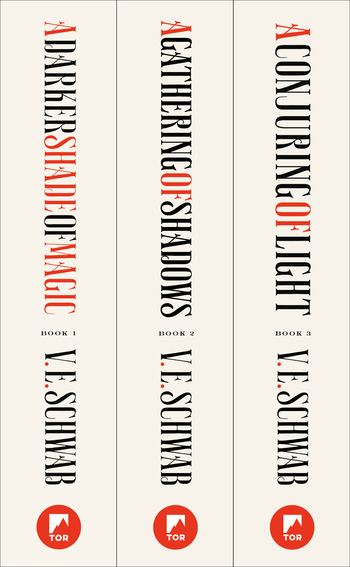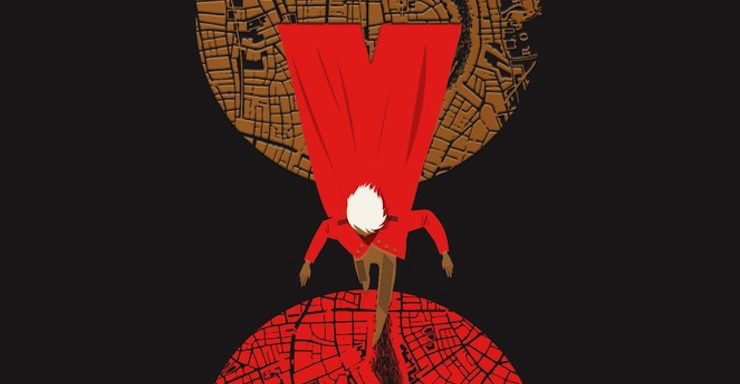I am fifteen. I am in a white, floor-length beaded dress that corsets at the back. My hair is curled, set with hairspray, with flower-shaped crystal clips set in. For the first time in my life I have fake acrylic nails, squared off at the tip, with a delicate floral pattern painted on the ring finger. My mother has loaned me her jewelry, a delicate diamond necklace that sits just over my collarbone. I am on my way to my first prom.
Lila Bard is nineteen. She is in Calla’s clothing shop in Red London surrounded by finery. She picks up a black half-mask with two horns spiraling up from the temples. Forgoing the available dresses, she wears a black tunic, fitted trousers, and a pair of black boots made of soft, supple leather. She selects a dramatic high-collared black velvet coat with a half-cloak over her shoulders and glassy red clasps. She is on her way to a masquerade at the palace.
In this moment, Lila notices how the boots help her appear taller, how the coat broadens her shoulders. She believes she looks like a king (no, a conqueror). The sentiment is echoed by the seamstress Calla, who says she looks “more ready to storm a city than seduce a man”. Which, knowing Lila, is the most likely scenario of the two.
It is not the first time Lila wants to appear more masculine, and certainly not the first time that doing so helps her move through her world with more ease, without limits. When we first meet Lila Bard in Grey London, she purposely lowers her voice when interacting with strangers on the street. She wears a top hat, and answers when called sir. She is proud of the WANTED poster her likeness appears on – a poster that seeks a male pickpocket – and the illusion she has built makes her smile. She enjoys when women flirt with her, thinking she’s a man. She wants to appear strong, powerful, and dangerous.
At the time I first read A Darker Shade of Magic, I was only just starting to figure out my relationship with gender. I’ll admit that I came to it later in life – before my mid-twenties, I hadn’t heard anyone use the term ‘genderfluid’ or ‘nonbinary’ before. What I knew was that the performance of femininity had always made me feel uncomfortable. It always felt fake, like something I was doing for the benefit of others rather than for myself. I hated having my hair done (a sentiment leftover from my childhood, when strangers would touch and pull at my curls), I hated dresses that went past my knees, that restricted my movement in any way. My first prom was the first and only time I have worn fake nails – I picked them off with a scissor two days later. And I hated, more than anything, being told that I wasn’t allowed something because I was a girl.
It was more than just being a tomboy. In my youth, that was the only term we had for what I was – assigned female at birth, but preferring to dress in boy’s clothes and play sports. Though for me, it was never about the sports themselves; I wanted the boys to accept me as one of their own, and that was the easiest way to do it. I went to great lengths to prove my strength and ability. I ran faster, hit harder, and was incredibly competitive in the quest to be seen as capable. I asked my mother to buy me jeans from the boy’s section of Old Navy, which I wore with baggy t-shirts to hide a body that was starting to change.
Gender is hard, you guys.
I felt very much like Lila does – excited by the prospect of being seen as masculine. And while the realization of the fact that I was not cisgendered involved a lot of deconstructing my internalized misogyny (the concept that masculinity equates to strength and power, or that it helps move a body more easily through the world is problematic), it came easily and as a huge relief. Finally I had a word for the way I had felt all my life – not a boy, but not really a girl either. I am happy to straddle both, to flow between the two poles on the spectrum of gender presentation, to inhabit the liminal space wherein gender becomes play rather than innate.
Buy the Book


The Shades of Magic Series
In A Gathering of Shadows, the sequel to A Darker Shade of Magic, we see Lila perform femininity in a new way. Having successfully joined a pirate crew as a man (for the most part, escaping all but the keen and clever Captain Alucard Emery), Lila puts on a dress in order to trick a rival pirate crew – a full skirt and a corseted waist which constricts her breathing. She sums up the experience pretty clearly – “why in god’s name must women do this to themselves?” When it’s time, she rips off the skirt of the dress and is shown to be wearing trousers underneath. And while clothes are just a small part of the genderfluid experience, it is clear that this is Lila’s true form – she feels most comfortable in trousers, moving through the world as a man, allowing the illusion to persist. Femininity, to Lila, becomes a costume. Later, she uses this tactic again, at another event at Red London’s palace. Again Lila puts on a dress – one that reminds her of “sharp knives and stars and freedom”. This time, the dress allows her to pass through the ball unnoticed, blending in with other women who have come to see the spectacle of royalty.
“That’s all this was, really: another disguise”, she thinks to herself. This is not who she is, not the image she wants to project out into the world. And during her conversation with Calla, she mentions that she’s “always been unique”. Lila knows that femininity isn’t for her, it never has been. The only thing performing femininity has done to benefit Lila is to help her appear small and unassuming – when she is, in reality, quite the opposite.
I remember the feeling of my first prom, standing there in that elaborate dress. I thought, or I’d been told, that I’d feel like a princess. What I really felt was uncomfortable – a feeling which has persisted any time I’ve had to put on an elaborate dress, any time someone else has done my makeup or my hair, or any time I’ve been told to act “like a lady”. The truth is that it just isn’t me, there’s something about that girl-version of me that isn’t the whole story. There’s more underneath. I am either, both, and neither all at the same time.
We have to understand that gender is performative, and a spectrum. This isn’t, of course, to say that cisgendered women can’t wear pants, or that any version of femininity undermines their strength and power. Quite the opposite. But allowing myself to move beyond the limits of ‘man’ and ‘woman’ brought me to a better understanding of myself, a space that explained the discomfort I’d felt all those years. Existing as both, fluctuating between masculinity and femininity, gave me comfort unlike anything else. And like Lila, gender becomes a costume, a tool, an adventure.
And the possibilities are endless.
As Travars.










